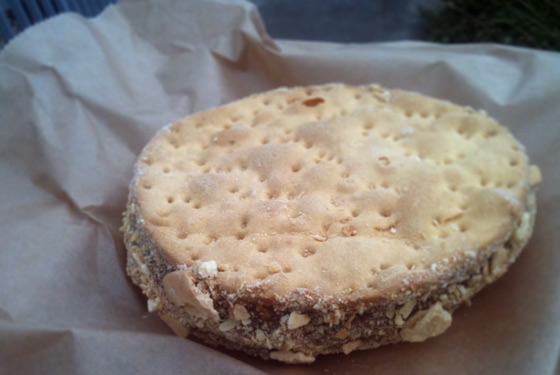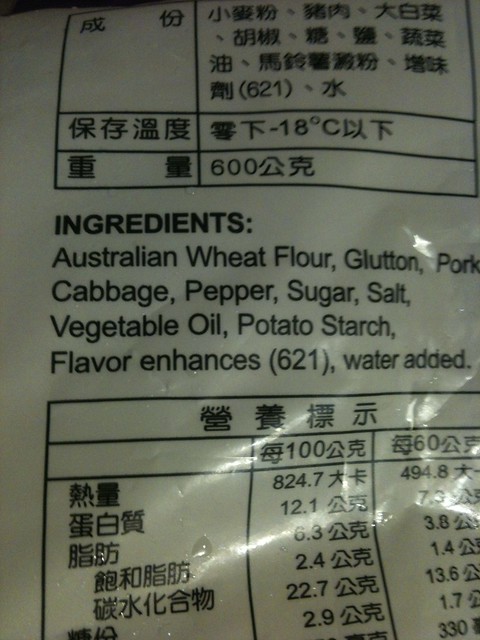Spotted on a packet of pork and cabbage dumplings, Footscray
Posts Tagged → Footscray
Sneakers, Footscray

Footscray Market Christmas Opening Hours 2010
As my local market still doesn’t seem to have a website, the posted opening hours for the Footscray Market this Christmas are:
Tuesday 21 December: 7:00am-4:00pm
Wednesday 22 December: 7:00am-6:00pm
Thursday 23 December: 7:00am-6:00pm
Friday 24 December (Christmas Eve): 7:00am-8:00pm
Saturday 25 December (Christmas Day): Closed
The market will remain closed until Wednesday 29 December. Consider my public service duties for the year fulfilled.
Phở Tam, Footscray
I’ve been a bit down on the phở scene in Footscray over the last few months.
One of my regular go-to joints, Phở Tam on the corner of Leeds and Ryan streets has been hugely inconsistent on the soup front. They do a great bún riêu and have the hardish-to-find street food bánh bột lọc on the menu. Their phở bộ đặc biệt is above average: always packed with sizeable chunks of tendon, a thick slice of peppery sausage and toothsome strips of tripe.
The broth however ranges from sweet and watery to dense, beefy and rich depending on which day you hit it. I’m convinced that the broth gets watered down on a busy day, especially weekends; an undeniable conspiracy against the nine-to-five working man. The consolation is the above cà phê sữa đá – condensed milk sweet, rich and as predictable as a metronome.
Location: Corner of Leeds and Ryan Street, Footscray, Melbourne, Australia.
Alfajores in Maidstone

Melbourne’s west never ceases to dumbfound me when it comes to food. Maidstone is one of Melbourne’s least remarkable suburbs and thanks to the housing boom is making the direct transition from unremarkable council flats to unremarkable McMansions; rusting Camrys in the front yard making way for houses that touch three of the four boundaries of a property. The shopping strip on Mitchell St however is possibly the only place in Australia where a Sichuan takeaway joint is next door to a South American cake shop. It’s a veritable barrio chino.
Marciano’s Cakes in Maidstone specialises in South American sweets of which the above alfajor is representative. It’s a biscuit filled with dulche de leche and probably about ten times my daily intake of glucose in a single hit. I have no idea if this is a good one: it’s the first that I’ve ever seen.
West Footscray Station, Evening
Sapa Hills, Footscray
There are two generations of Vietnamese restaurants in Footscray, Melbourne. The first emulates the tile-and-mirror-walled, cheap metal table joints of the streets of Saigon. The architecture sends a message that hosing down the walls could be a priority, the hall of mirrors effect suggests that the appearance of being busy is as important as really being busy. The second generation is identical to upmarket phở chain, Phở 24 with dark timber panelling, dark timber seats, white plates, the appearance that they’re one frappucino short of a Starbucks.
In Footscray, both tend to serve the same menu; interior design is not a handy marker of a great or terrible meal.
Sapa Hills opened in November 2009 and falls into the second generation with the added bonus of shots of the actual terraced hills of Sapa on the wall. The menu isn’t from northern Vietnam – it’s much the same as every other Melbourne pho joint – but there is the occasional plate from the north, like the above bo la lot: fatty and peppery beef mince wrapped in a betel nut leaf (although here, vine leaves substitute(?)), topped with peanuts.
The argot of Northern Vietnamese food is meat and the above is bun cha at it’s blunt meaty best. Grilled thin slices of pork and well charred meatballs with a thin vinegary, green papaya-topped stock. Greens are varied and bun noodle serve are generous.
Location: 112 Hopkins St, Footscray VIC 3011
“It’s a minefield even for Asians”
I had dinner on Saturday at Poon’s Chinese Restaurant in Barkly Street, Footscray. It was the worst Cantonese meal that I’ve eaten in Melbourne. The service was gracious and friendly considering that they were packed and it was dirt cheap. The meal was a mistake but not an expensive one and it filled me with regret but not salmonella. The food was uniformly tasteless like some non-toxic, starchy glue.
Poon’s however, is popular enough to be ranked a local institution much of which seems to revolve around the ritual of regular dining in the same place over a period of decades. The result of a family decision where Friday night is fish and chips, Saturday night is Poon’s. Single sex groupings dining together, having the Boy’s Night Out with a table filled with Crownies; women on other tables sharing a bottle of Jacob’s Creek Chardonnay and splitting Poon’s gigantic (and suspiciously Chiko Roll-like) spring rolls. There were no chopsticks on offer, anywhere.
At a guess, it has been doing the same food in the same place for half a century and the punters love it. Here’s a review from Menulog:
i have been a ‘patron’ of ‘Poons’ for at least 40 years, and would not go anywhere else. The food is fresh, nutritional and very easy to eat. The variations on the Menu are wonderful.
The staff and Management have ALWAYS been good to me and i feel part of their family after all these years, at being treated as part of their family.
i only wish they could deliver to Carlton to where i live, but at least i get a chance to mix with some of the ‘cream of the crop people in our Society when i visit them regularly.
Thank you for allowing me to tell you this wonderful news about ‘Poons’. ( i tell everyone i go there and love it and the staff too )
Who in Australia cares about “Asian food” in a world where Poon’s is rating as well as Flower Drum or Lau’s on user-generated review sites?
When it comes to food from Asia, most Australians are happy with average food. “Chinese food” means a regionless choice of meat stir fried in your choice of bland starchy sauce. Most Australians are content with the local Thai joint doing the traffic light curries (red, green, yellow) straight from the bucket of Mae Ploy. Vietnamese means pho alone. Japanese is aseasonal and what rich people eat (except for sushi, which is no longer associated with Japan). The rest of Asia is a vague unknown, summarised in the thinner chapters of cookbooks with the word Oriental
in the title. Above all, the food must be “very easy to eat”. No bones, no heads, no need to even chew.
So Necia Wilden’s article in The Australian newspaper regarding her inability to find or discern premium Asian ingredients was no great surprise to me. Boneless and free from the shackles of mastication. I’m only bringing it up because of the interesting discussion it has spawned over at Progressive Dinner Party. Like Zoe, I read it in the physical newspaper. I paid good money for it in the hope that food journalism in The Australian (and coverage of food from Asia) would be better in 2009 under Lethlean and Wilden’s gaze. I haven’t bought an edition of The Australian since. If it’s been a bumper year for food writing in The Australian, apologies for not supporting it.
I’m not going to tackle the racism behind grouping food from Asia together into an undifferentiated and monolithic bloc, skipping between cuisines as if there was no need for specialist knowledge in any of them. Provincial food for The Australian, it seems, only comes from refined palates in Europe.
It’s the Chicken Tonight approach to food that also concerns me: if only I had the right stir-through sauce recommended to me as authentic, the curry would taste the same as at my hotel in Phuket. So how to come by this knowledge? Getting a recommendation from the person that owns the store is just not good enough, as Wilden puts it:
“How do I know this soy sauce is organic?” I ask the young woman in the Japanese grocery store near my home. “Because it says so on the label,” she says, pointing to the Japanese characters on the bottle’s posh paper wrapping. Ah, right.
The key, according to the article, is to get a chef to tell you what is good, preferably one with an Asian last name or a cookbook the size of a family sedan. Actually going out, buying a few things and then tasting them is not mentioned. You only learn to cook through your own experiences and your sense of taste is subtly different to everyone else and above all, should be trusted. If David Thompson recommends Megachef brand fish sauce but you enjoy $3 a bottle Tiparos, go with your own tastes. At most, experimenting with different brands will be less than $5 a hit.
Buying ingredients is no minefield as Tony Tan mentions in the article, at least in comparison to the minefields that I’ve seen built for Cambodians and by Cambodians. Ask the shopkeeper. Try different things. You won’t step on anything that will turn you, your children or your livestock into a fine pink mist. So who is this article meant to service? What is to gain from making cooking certain cuisines at home look more difficult and less satisfying?
Just to put on a particularly Bolshie hat, newspapers have so little to gain from pimping out fresh food – it is the Simon Johnson’s of the world that buy ads in the food sections of newspapers and not your local Vietnamese grocer. There is a need for newspapers to prop up a system that recommends branded goods over raw ingredients. If word got out that fresh ingredients make much more of a difference in cooking than processed ones, all hell would break loose. People would be smashing in the Lean Cuisine fridges in your local duopolist supermarket in a fit of rage.
Just to bring things back to the world of Poon’s rather than some parallel universe where people care about what they eat, The Australian’s food section is aimed squarely at the Poon’s market and not at me. It’s aimed at people who buy the best fish sauce as a display to others that they buy the best fish sauce rather than as a pungent condiment whose value is in its consumption. This is the food journalism for the people who have been eating the same Chinese food for decades and are unwilling or unable to try somewhere new without someone else validating and translating the experience for them.





